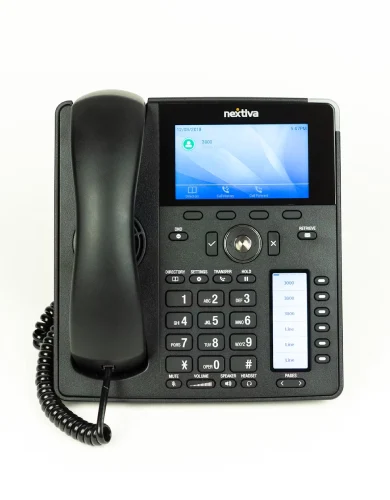Session Initiation Protocol (SIP)
Online video and voice calls are routine at any business. But behind this mundanity, there are decades of technological development.
One of these is the Session Initiation Protocol (SIP), a set of rules that are essential for VoIP calls. Without SIP, we’d be stuck with traditional business phone lines, and the PSTN switch off would never happen.
This article explains SIP in simple terms, how its used across the VoIP industry, and its importance to UK businesses.
Contents:
- What is Session Initiation Protocol (SIP)?
- How does SIP work?
- What apps use Session Initiation Protocol (SIP)?
- SIP security considerations
- SIP alternatives
What is Session Initiation Protocol (SIP)?
Session Initiation Protocol (SIP) is the signalling protocol used in business VoIP solutions such as Microsoft Teams, Zoom and Cisco Webex, signalling when to initiate, maintain, and terminate real-time communication sessions.
In other words, these apps attach SIP signals to the voice or video data transmitted between caller and receiver to indicate different actions. For example, the caller’s device sends a ‘ringing’ SIP signal to make the receiver’s device vibrate, and the receiver’s device sends a ‘termination’ SIP signal when the receiver ends the call.
This makes online VoIP communications reliable and efficient because it removes miscommunications or extra signalling translation. The same app on any device in any country can understand the signals and act accordingly.
This is as important as deciding on a global time zone system to facilitate international meetings or deciding on English as the international business language: it makes things more efficient!
Analogy of Session Initiation Protocol
One way of looking at SIP is by comparing it to Western social cues that can be effectively understood by any Westerner, no matter where they are in the world, their gender, their hobbies, profession, or age:
- Shake someone’s hand: You are officially engaging with that person; it’s OK to start speaking.
- Saying “it’s getting late”: You want to end the conversation politely.
- Asking “how was it?”: You want to maintain the conversation.
- Look at your watch: You’ve got somewhere to be and will end the conversation soon.
Session Initiation Protocol (SIP) works similarly to these cues but at the device level. Apps include these universal ‘gestures’ in their voice and video traffic to efficiently indicate the call’s status.
How does SIP work?
Communication apps using SIP (Session Initiation Protocol) issue a series of ordered SIP messages to set up, manage, and terminate calls.
| Step | Step Description | Details |
|---|---|---|
| 1 | Registration | User's device registers with a SIP server, indicating its location on the network. |
| 2 | Invitation | User A's device sends an INVITE request to the SIP server to initiate a call with User B. |
| 3 | Routing | SIP server routes the INVITE request to User B's device. |
| 4 | Response | User B's device responds with provisional responses (e.g., 100 Trying, 180 Ringing) and a final response (200 OK). |
| 5 | Acknowledgement | User A's device sends an ACK message to confirm the session establishment. |
| 6= | Media Exchange | Voice, video, or data is exchanged between User A and User B using protocols like RTP. |
| 6= | Modifications | During the session, either party can send SIP messages to modify the session (e.g., adding participants, holding). |
| 7 | BYE Request | Either party sends a BYE request to end the call. |
| 8 | Response | The other party responds with a 200 OK message, confirming the session termination. |
This allows both devices to communicate efficiently, establishing clear voice and video communications with minimal bandwidth and latency requirements.
In contrast, if each had to use ‘signalling translators’ to switch from one system to another instead, a faster connection would be needed to reach the same level of performance.
SIP-based communications require a stable and high-speed broadband connection. Compare business broadband deals to find the best options for your business.
The importance of SIP for businesses
Sessions Initiation Protocol (SIP) is one of the foundation technologies of VoIP, which has revolutionised business voice communications.
Traditional business phone lines (PSTN) are more expensive and have limited functionality. In contrast, business VoIP prices are lower, and it has unparalleled functionality thanks to VoIP integrations with other cloud-based software.
Advanced VoIP features like automated call forwarding to mobile VoIP apps and call analytics would not be possible without SIP.
What apps use Session Initiation Protocol (SIP)?
While popular messaging apps like WhatsApp and Google Meet use alternative communication protocols, business-oriented apps still use the more interoperable SIP rulebook.
Here is a list of popular business platforms that use SIP behind the scenes:
| App Name | Description | Key Features |
|---|---|---|
| Microsoft Teams | Collaboration platform with messaging, video conferencing, and calls | Integration with Office 365, VoIP calls, video meetings |
| Zoom | Video conferencing and online meeting app | High-quality video/audio, screen sharing, webinar support |
| Cisco Webex | Web conferencing and video conferencing service | Secure calls, screen sharing, integration with Cisco products |
| RingCentral | Cloud-based communications and collaboration platform | VoIP calls, video meetings, team messaging, integration with business apps |
| 8x8 | Unified communications as a service (UCaaS) | VoIP, video conferencing, team chat, contact centre solutions |
| Avaya OneCloud | Unified communications and collaboration solution | VoIP, video conferencing, team collaboration tools |
| Mitel | Business phone line provider | VoIP, video conferencing, contact centre solutions |
| Vonage Business | Cloud communications provider | VoIP, video meetings, team messaging, CRM integration |
SIP security considerations
Since Session Initiation Protocol (SIP) is a universal, open-sourced protocol used in multiple enterprise platforms, most of its cybersecurity relies on foundational actors such as those maintaining the protocol and those using it in their platforms:
- Foundation level: The international community of volunteers (IETF) that maintains SIP ensures the codebase is safe to prevent Zero-Day Exploits.
- App and Network level: Developers working for the apps (Zoom, Microsoft, Cisco) ensure that SIP is integrated safely within their platforms, providing authentication, access control, robust encryption, etc. Network administrators ensure these remain infallible by monitoring the network.
SIP cybersecurity for businesses
The security responsibilities that fall onto businesses due to SIP are different. Essential cybersecurity measures include:
- Choosing secure apps: Popular communication apps from reputable providers like Microsoft and Cisco, known for robust security practices.
- Updating Software: Regularly updating software to ensure the latest versions are used on all devices.
- Training Employees: Educating employees on secure usage practices is critical, such as recognising phishing attempts that have been the cause of some of the largest cybersecurity attacks in UK history.
- Strong Authentication: Using strong passwords and enabling multi-factor authentication for maximum VoIP security.
- Access Control: Limit access to communication tools based on job roles and responsibilities. Many businesses are now switching to Zero-trust network access to make this process easier and safer.
SIP alternatives
Session Initiation Protocol (SIP) is the best-known signalling protocol because it is universally standardised, supports various formats (voice, video, text), and is designed to work in a wide range of devices and operating systems. Its importance comes from this neutrality, flexibility and interoperability.
However, popular platforms usually develop proprietary, customised signalling protocols to cover specific requirements such as different encryption and interoperability with proprietary, closed-source apps. Here are some popular alternatives:
| Protocol | Differences from SIP | Use Cases | Popular Apps Using It |
|---|---|---|---|
| WebRTC | Direct peer-to-peer communication via web browsers | Video calling, voice calling, data sharing | Google Meet, Discord, appear.in |
| H.323 | Protocol suite for multimedia communication over IP networks | Video conferencing, enterprise communication | Polycom, Cisco Webex |
| MGCP | Centralised control of media gateways on IP networks | VoIP calls to PSTN | Cisco CallManager, BroadSoft |
| IAX (IAX2) | Efficient bandwidth usage and simple firewall traversal | VoIP trunking, Asterisk PBX communication | Asterisk-based systems |
| Jingle | XMPP extension for multimedia sessions | Instant messaging with voice and video | Google Talk (deprecated), Jabber |
Sessions Initiation Protocol (SIP) – FAQs
Our business broadband experts answer commonly asked questions regarding Sessions Initiation Protocol (SIP):
Who develops and maintains SIP?
SIP (Session Initiation Protocol) is maintained and standardised by the Internet Engineering Task Force (IETF), an open international community of network designers, operators, vendors, and researchers concerned with the evolution of Internet architecture and its smooth operation.
Specifically, the development and maintenance of the SIP protocol falls under the purview of the IETF’s SIP Working Group, which is responsible for addressing any issues, updates, or enhancements related to SIP. They produce documents, known as Request for Comments (RFCs), which detail the specifications and updates to the protocol.
It’s worth noting that while the IETF standardises the protocol, individual developers and companies are responsible for the actual implementation and use of SIP in various products and services. They often refer to the IETF’s RFCs to ensure they adhere to the standard.
Read our full guide on SIP Trunking.
Is Session Initiation Protocol (SIP) open-source?
SIP is an “open standard”, which means its specifications are publicly available, and anyone can implement them without facing licensing restrictions from the IETF.
SIP is a set of rules (protocol), not software, so it cannot be “open-source” specifically, as this usually refers to code. However, many SIP open-source software implementations exist, such as Asterisk, FreeSWITCH, and Kamailio.
Does my broadband have SIP?
This question is badly phrased and makes little sense because SIP is a protocol used for messaging between devices (software), and broadband is like the internet’s piping (hardware), carrying data on high-bandwidth fibre-optic cables worldwide.
They are completely different things. Your business broadband provider will not give you SIP. Instead, SIP files are pre-installed on business phone line hardware or within specific messaging applications on smartphones, tablets, or computers.
When you download a SIP-based app (like Teams or Zoom), it comes with its SIP stack that allows the app to handle SIP communications.
How does a device find another?
Devices use another protocol, TCP/IP, to determine the device’s location they want to communicate with. It all starts when a device hops onto the internet and is automatically assigned a static IP or dynamic IP address, which indicates where it is located within the internet. It’s like a device’s internet postcode.

